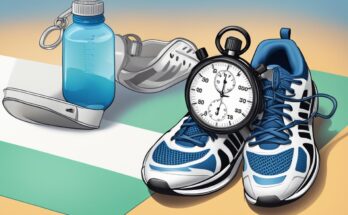Running is a popular form of exercise that has numerous health benefits. Many people find that running gets easier with time, but why does this happen? The answer lies in the way the body adapts to the physical demands of running.
When a person begins running, their body has to work harder to meet the demands of this new form of exercise. The heart has to pump more blood to supply the muscles with oxygen, and the lungs have to work harder to bring in enough air. Over time, the body becomes more efficient at meeting these demands. The heart becomes stronger and can pump more blood with each beat, and the lungs become more efficient at taking in oxygen. As a result, running feels easier and less tiring.
Another reason why running gets easier is due to the development of muscle memory. As a person continues to run, their muscles become accustomed to the repetitive motions and learn to perform them more efficiently. This means that less energy is required to perform the same movements, making running feel easier and more natural. Overall, the body’s ability to adapt and become more efficient is what makes running easier over time.
The Science Behind Running
Running is an excellent form of exercise that provides numerous health benefits. However, it is important to understand the science behind running to maximize its benefits. This section will explore how running affects the body, the role of age and body type in running, and the importance of muscles in running.
How Running Affects the Body
Running is a high-impact exercise that puts a lot of stress on the body. When a person runs, their body weight is multiplied by two to three times, which can cause wear and tear on the joints. However, running also has numerous benefits for the body. It can help improve cardiovascular health, strengthen bones, and reduce the risk of chronic diseases.
Running also affects the body’s metabolism. When a person runs, their body burns calories and fat for energy. This can help with weight loss and weight management. Running also releases endorphins, which can improve mood and reduce stress.
The Role of Age and Body Type in Running
Age and body type can play a significant role in a person’s ability to run. As a person ages, their body undergoes changes that can affect their running ability. For example, muscle mass decreases with age, which can lead to a decrease in strength and endurance.
Body type can also affect a person’s ability to run. People with a larger body mass may find running more challenging due to the increased stress on their joints. However, with proper training and conditioning, people of all ages and body types can improve their running ability.
The Importance of Muscles in Running
Muscles play a crucial role in running. When a person runs, their muscles contract and relax to propel the body forward. The primary muscles used in running are the quadriceps, hamstrings, glutes, and calves. These muscles work together to provide power and stability during running.
To improve running performance, it is important to strengthen these muscles through targeted exercises such as squats, lunges, and calf raises. Strong muscles can also help reduce the risk of injury during running.
In conclusion, running is a great form of exercise that provides numerous health benefits. Understanding the science behind running can help individuals maximize its benefits and improve their running performance. By focusing on proper training, conditioning, and muscle strengthening, people of all ages and body types can enjoy the benefits of running.
Training for Running
How to Train for Running
Training is an essential aspect of running. It is crucial to train regularly to improve endurance and build strength. Running can be challenging for beginners, but with the right training, it can become more comfortable over time. Here are some tips on how to train for running:
- Start slow and gradually increase the intensity of your runs. Begin with short, easy runs and slowly increase your distance and pace over time.
- Incorporate interval training into your routine. This involves alternating between periods of high-intensity running and periods of rest or low-intensity running.
- Cross-train to improve your overall fitness. Activities such as cycling, swimming, or weightlifting can help strengthen your muscles and improve your endurance.
- Take rest days to allow your body to recover and prevent injuries.
The Role of Pace in Running
Pace is an essential aspect of running. It refers to the speed at which you run and can have a significant impact on your performance. Running at a comfortable pace can help you run longer distances and prevent injuries. Here are some tips on how to maintain a good pace:
- Find a comfortable pace that you can maintain for an extended period.
- Use a heart rate monitor to ensure you are running at an appropriate intensity.
- Focus on your breathing and try to maintain a steady rhythm.
- Use a metronome to help you maintain a consistent pace.
Tips for New Runners
Starting a running routine can be challenging, but with the right approach, it can be a rewarding experience. Here are some tips for new runners:
- Invest in a good pair of running shoes that fit well and provide adequate support.
- Start with short, easy runs and gradually increase your distance and pace over time.
- Set achievable goals and track your progress.
- Find a running partner or join a running group for motivation and support.
The Importance of Energy in Running
Energy is essential for running. It fuels your muscles and helps you maintain a consistent pace. Here are some tips on how to maintain energy levels during your runs:
- Eat a balanced diet that includes carbohydrates, protein, and healthy fats.
- Stay hydrated before, during, and after your runs.
- Consider using energy gels or sports drinks to help maintain your energy levels during long runs.
- Get adequate rest to allow your body to recover and recharge.
Running in Different Conditions
Running is a great way to stay fit and healthy, but it can be challenging to keep up with it if you don’t enjoy the conditions you’re running in. Whether it’s cold weather or running at night, different conditions can have an impact on your running experience. Here are some things to consider when running in different conditions.
Running in Cold Weather
Running in cold weather can be a challenge, but it can also be invigorating. Here are some tips for running in cold weather:
- Dress in layers: You want to stay warm, but you also don’t want to get too hot and sweaty. Dress in layers so you can adjust your clothing as needed.
- Wear a hat and gloves: You lose a lot of heat through your head and hands, so make sure to wear a hat and gloves to keep warm.
- Warm up indoors: Do some light stretching and warm-up exercises indoors before heading out into the cold.
- Be visible: Make sure to wear reflective clothing or a headlamp if running in low-light conditions.
Running at Night
Running at night can be a great way to fit in a workout when you have a busy schedule. Here are some tips for running at night:
- Wear reflective clothing: Make sure you’re visible to drivers and other pedestrians by wearing reflective clothing or a headlamp.
- Stick to well-lit areas: Avoid running in areas that are poorly lit or have a lot of obstacles.
- Run with a buddy: Running with a friend or group can make you feel safer and more motivated.
- Be aware of your surroundings: Stay alert and aware of your surroundings to avoid any potential dangers.
Running a 5K
Running a 5K can be a fun and rewarding experience, but it can also be intimidating if you’ve never done it before. Here are some tips for running a 5K:
- Train properly: Make sure to train for the race by gradually increasing your distance and speed.
- Pace yourself: Don’t go out too fast or you’ll burn out before the end of the race.
- Stay hydrated: Drink plenty of water before, during, and after the race to stay hydrated.
- Have fun: Remember that running should be enjoyable, so don’t put too much pressure on yourself to perform.
Whether you’re running in cold weather, at night, or a 5K race, it’s important to be prepared and stay safe. By following these tips, you can make the most of your running experience and achieve your fitness goals.
Improving Running Performance
The Role of Oxygen in Running
Oxygen plays a crucial role in running. The more oxygen your muscles receive, the more efficiently they can produce energy. This is why proper breathing techniques are essential to running performance. When you inhale, your lungs take in oxygen, which is then transported to your muscles via your bloodstream. To improve your running performance, focus on breathing deeply and rhythmically, inhaling through your nose and exhaling through your mouth.
The Importance of Recovery
Recovery is a vital component of running performance. Your body needs time to rest and repair itself after a workout. This is when your muscles grow stronger, and your endurance improves. To optimize your recovery, make sure you are getting enough sleep, eating a balanced diet, and staying hydrated.
The Role of Sleep in Running
Sleep is essential for overall health and well-being, but it is especially important for runners. During sleep, your body repairs and regenerates tissues, including your muscles. Aim for 7-9 hours of sleep per night to optimize your running performance.
How to Build Endurance
Endurance is the ability to sustain physical activity over an extended period. Building endurance takes time and effort, but it is essential for improving running performance. To build endurance, gradually increase the distance and duration of your runs. Incorporating interval training and hill repeats can also help improve your endurance.
The Role of Intensity in Running
Intensity refers to the level of effort you put into your runs. The intensity of your runs can vary depending on your goals and fitness level. High-intensity interval training (HIIT) can help improve your running performance by increasing your aerobic capacity and improving your body’s ability to use oxygen.
Preventing Injuries
Injuries can be a significant setback to running performance. To prevent injuries, make sure you are wearing proper footwear, warming up before your runs, and stretching afterward. Incorporating strength training and cross-training into your routine can also help prevent injuries by strengthening your muscles and improving your overall fitness.
Improving running performance takes time and effort, but by focusing on these key areas, you can optimize your performance and reach your goals.
Running Long Distances
How to Train for a Marathon
Training for a marathon requires a significant amount of time, effort, and dedication. It is essential to start with a solid base of running fitness before beginning a marathon training plan. This means gradually building up your mileage and endurance over several months.
A typical marathon training plan lasts for 16-20 weeks and includes a mix of long runs, tempo runs, speed work, and recovery runs. It is important to follow the plan closely to avoid injury and build up the necessary endurance and strength to complete the marathon.
The Importance of Legs in Running
Strong legs are essential for running long distances. The quadriceps, hamstrings, calves, and glutes all play a significant role in propelling the body forward. It is important to include strength training exercises that target these muscles in your training plan.
In addition to strength training, stretching and foam rolling can help prevent injuries and improve flexibility. This is especially important for runners who are prone to tightness in the legs and hips.
Adapting to Running Long Distances
Adapting to running long distances can take time and patience. It is important to listen to your body and make adjustments as necessary. This may mean slowing down your pace or taking extra rest days.
Fueling and hydration are also crucial for long-distance running. It is important to consume enough carbohydrates and electrolytes before, during, and after your runs to maintain energy and prevent cramping.
Overall, running long distances requires a combination of physical and mental strength. With proper training, strong legs, and a willingness to adapt, anyone can complete a marathon.
The Science of Running Performance
The Cardiovascular System and Running
The cardiovascular system plays a crucial role in running performance. When an individual runs, their heart rate increases, and blood is pumped more rapidly to the muscles, providing them with the necessary oxygen and nutrients to function. As the muscles work harder, they produce more waste products, such as carbon dioxide, which must be removed from the body. The cardiovascular system helps to transport these waste products away from the muscles and back to the lungs, where they can be exhaled.
The Role of Threshold and VO2 Max in Running
Two important factors that affect running performance are threshold and VO2 max. Threshold refers to the point at which an individual’s body can no longer keep up with the demands of exercise, leading to fatigue. VO2 max, on the other hand, is a measure of the maximum amount of oxygen that an individual can consume during exercise. Both of these factors are influenced by genetics, but can also be improved through training.
The Importance of Consistency and Stamina
Consistency and stamina are also critical factors in running performance. Consistency refers to the ability to maintain a regular training schedule, which can help to improve fitness levels over time. Stamina, on the other hand, refers to an individual’s ability to sustain physical activity for an extended period of time. Both of these factors can be improved through regular training and conditioning.
Why Running Gets Easier Over Time
As an individual continues to run and train, their body adapts to the demands of exercise, and running becomes easier over time. The body becomes more efficient at transporting oxygen to the muscles, and the muscles themselves become stronger and more resilient. Additionally, the body becomes better at removing waste products, such as lactic acid, which can cause fatigue and muscle soreness.
In conclusion, running performance is influenced by a variety of factors, including the cardiovascular system, threshold, VO2 max, consistency, and stamina. With regular training and conditioning, individuals can improve their running performance and make running easier over time.
Motivation and Running
The Role of Music in Running
Music can play an important role in motivating runners during their workout. Studies have shown that listening to music while running can improve performance by increasing motivation and reducing fatigue. Music with a faster tempo can also help runners maintain a consistent pace and improve their overall speed. However, it’s important to be aware of your surroundings while listening to music and to use caution when running in busy or high-traffic areas.
The Importance of Motivation
Motivation is key to a successful running routine. Setting goals and tracking progress can help keep runners motivated and focused. Finding a running partner or joining a running group can also provide accountability and support. It’s important to remember that motivation can fluctuate, and it’s okay to take a break or adjust goals as needed.
The Role of Rest Days in Running
Rest days are just as important as running days. Rest allows the body to recover and can help prevent injury. It’s important to listen to your body and take rest days as needed. Incorporating low-impact activities, such as yoga or swimming, on rest days can also provide benefits without putting additional strain on the body.
The Importance of Warming Up
Warming up before a run can help prevent injury and improve performance. Dynamic stretching, such as leg swings or lunges, can help prepare the body for exercise. Starting with a slower pace and gradually increasing speed can also help prevent injury and improve overall performance.
The Role of Temperature in Running
Temperature can play a role in a runner’s performance and comfort. Running in extreme heat or cold can be dangerous and should be avoided when possible. On hot days, it’s important to stay hydrated and wear lightweight, breathable clothing. On cold days, layering clothing can help regulate body temperature and prevent hypothermia. It’s important to be aware of weather conditions and adjust running plans accordingly.
Overall, staying motivated and taking care of the body are key to a successful running routine. Incorporating strategies such as music, rest days, warming up, and being aware of temperature can help improve performance and prevent injury.
Tips for New Runners
How to Start Running
For those who are new to running, it is important to start slowly and gradually increase the intensity and duration of the runs. Here are some tips to help get started:
- Start with a brisk walk for 5-10 minutes to warm up before running
- Set realistic goals for distance and time
- Invest in a good pair of running shoes to prevent injury
- Consider joining a running group or finding a running partner for motivation and support
Tips for Running Performance
To improve running performance, consider the following tips:
- Incorporate interval training to improve speed and endurance
- Focus on proper form and technique to prevent injury and increase efficiency
- Incorporate strength training exercises to improve overall fitness and running performance
- Stay hydrated and fuel properly before and after runs
Running Routines
Establishing a consistent running routine can help improve overall fitness and running performance. Here are some tips for creating a running routine:
- Set a regular schedule for running
- Mix up the types of runs (long distance, interval, tempo) to prevent boredom and improve overall fitness
- Incorporate rest days to allow for recovery and prevent injury
The Role of Technology in Running
Technology can be a useful tool for runners to track progress and improve performance. Here are some ways technology can be incorporated into running:
- Use a GPS watch or running app to track distance, pace, and progress
- Consider using a heart rate monitor to track intensity and improve performance
- Utilize music or podcasts to stay motivated during runs
For those who use Apple products, there are several apps and tools available to help with running, including the Apple Watch and the Nike Run Club app.
The Importance of Physical Activity
The Dangers of Sedentary Living
Living a sedentary lifestyle can lead to various health problems such as obesity, heart disease, and high blood pressure. It is important to engage in physical activity to prevent these health issues and maintain a healthy body.
The Importance of Consistent Training
Consistent training is essential for improving running performance. By gradually increasing the intensity and duration of training, runners can build endurance and improve their overall fitness levels. However, it is important to avoid overtraining, as this can lead to injury and burnout.
The Role of Pain in Running
Pain is a common experience for runners, but it is important to distinguish between normal discomfort and injury. Runners should listen to their bodies and take appropriate rest and recovery time when necessary.
The Importance of Hydration
Proper hydration is crucial for runners to maintain their performance and prevent dehydration. Runners should drink water before, during, and after their runs to stay hydrated.
The Role of Diet in Running
A well-balanced diet is important for runners to fuel their bodies and maintain their energy levels. Carbohydrates are especially important for providing the energy needed for running. Runners should also aim to consume adequate amounts of protein and healthy fats to support muscle growth and recovery.
In conclusion, physical activity is essential for maintaining a healthy body and improving running performance. Runners should pay attention to their training, listen to their bodies, stay hydrated, and maintain a healthy diet to achieve their running goals.
Strength Training and Running
The Role of Strength Training in Running
Strength training is an essential component of running. It helps build and maintain muscle mass, which in turn helps improve running performance. Strength training also helps prevent injuries by strengthening the muscles and joints that are involved in running.
Runners should focus on strength training exercises that target the muscles used in running, such as the glutes, quadriceps, hamstrings, and calves. Some examples of strength training exercises that are beneficial for runners include squats, lunges, deadlifts, calf raises, and hip thrusts.
The Importance of the Run/Walk Method
The run/walk method is a popular training method among runners. It involves alternating between running and walking during a run. This method helps reduce the risk of injury by allowing the body to recover during the walking periods.
The run/walk method is also beneficial for beginners who are just starting out with running. It helps build endurance gradually, making it easier to complete longer runs over time.
The Role of Hydration in Strength Training
Hydration is essential for both strength training and running. Proper hydration helps prevent muscle cramps, fatigue, and dehydration. It also helps regulate body temperature and improve overall performance.
Runners should drink water before, during, and after a run to stay hydrated. Strength trainers should also drink water throughout their workout to stay hydrated.
The Importance of Clothing in Running
Choosing the right clothing for running is important for comfort and performance. Runners should wear clothing that is lightweight, breathable, and moisture-wicking. This helps regulate body temperature and prevent chafing.
It’s also important to wear proper running shoes that provide adequate support and cushioning. This helps prevent injuries and improve running performance.
The Role of Discipline in Running
Discipline is essential for success in running. It takes discipline to stick to a training plan, maintain a healthy diet, and stay motivated. Runners should set goals and work towards them consistently to improve their running performance.
Strength training also requires discipline. It takes time and effort to build strength and endurance. Consistency is key when it comes to strength training.
In conclusion, incorporating strength training, the run/walk method, hydration, proper clothing, and discipline into a running routine can help improve performance and prevent injuries.
Running for Weight Loss
Running is an excellent way to lose weight and improve overall health. Regular running can help individuals achieve their weight loss goals by burning calories and increasing metabolism. Here are some key factors to consider when using running as a weight loss tool.
The Role of Cardiovascular Fitness in Weight Loss
Cardiovascular fitness plays a crucial role in weight loss. Regular running sessions help improve cardiovascular fitness by strengthening the heart and lungs. As cardiovascular fitness improves, the body becomes more efficient at burning calories, leading to more significant weight loss. Additionally, running helps to reduce the risk of heart disease, high blood pressure, and other health conditions.
The Importance of Consistent Training for Weight Loss
Consistent training is essential for weight loss through running. It is essential to create a workout plan that includes running sessions at least three to four times a week. Gradually increasing the duration and intensity of the runs can help individuals achieve their weight loss goals. Consistent training can also improve running strength and endurance, leading to more effective weight loss.
The Role of Diet in Weight Loss
While running can help individuals lose weight, diet plays a significant role in weight loss. It is essential to consume a balanced diet that includes plenty of fruits, vegetables, lean protein, and whole grains. Avoiding processed foods, sugary drinks, and high-fat foods can help individuals achieve their weight loss goals faster. Additionally, it is crucial to stay hydrated by drinking plenty of water throughout the day.
In summary, running is an effective way to lose weight and improve overall health. Consistent training, a balanced diet, and improved cardiovascular fitness are essential to achieve weight loss goals through running.




